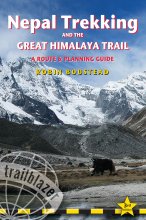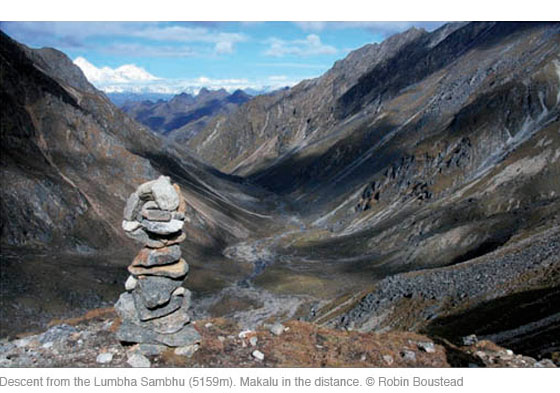These Trailblazer guides … are a godsend for independent travelers.
— Travel & Leisure

Nepal Trekking and The Great Himalaya Trail
Excerpt:
Route Guide: main trekking areas
Contents | Introduction | Planning your trek: trekking styles | Route Guide: main trekking areas | Kanchenjunga region
WHERE TO TREK?
From the landscaped, broad walking tracks of the classic trekking routes, to remote craggy trails occasionally used by locals, or high alpine passes that will challenge the most experienced, there is a path somewhere that is almost tailor-made for you.
There is an enormous disparity in the number of visitors to various regions of Nepal. By far the most popular trekking region is the Annapurna, where tens of thousands of visitors flock to destinations such as Poon Hill, the Annapurna Sanctuary and Circuit trails.
However, you only need to walk a few hours away from the main route and you’ll find yourself immersed in Nepali hill culture with rarely another tourist in sight. This is even more true for the remoter trekking regions to the extreme of the Api Nampa Conservation Area in Far West Nepal which receives a trekking group every few years.
SUMMARY OF THE MAIN TREKKING AREAS
Kanchenjunga [see pp115-24]
Kanchenjunga is the most easterly of the Nepal Himals and forms a natural border with the Indian state of Sikkim. The mountain’s south-west face, south ridge and west ridge form a massive and rarely visited horseshoe-shaped valley system around Yalung and includes sections of the Singalilla National Park.
Village-to-village trekking routes connect Singalilla with Taplejung and numerous trails towards Makalu and the Solu-Khumbu (Everest) regions.
The main Kanchenjunga Base Camp trekking route heads to the mountain’s north face and stone huts at Pangpema. The isolated communities of Olangchun Gola and Yangma are adventurous side trips that can be used as bases to visit some of the most far-flung corners of Nepal.
There are many ethnic groups in the region, including Limbu, Rai, Sherpa, Lhomi as well as Tibetan nomads who cross the border to trade.
Makalu [see pp124-35]
Makalu is sandwiched between Kanchenjunga and the Solu-Khumbu (Everest Region), but that doesn’t mean to say it’s any half measure! This is perhaps the most stunning and challenging of Nepal’s wilderness trekking areas.
The standard route to the base camp of the fifth highest mountain in the world, Mt Makalu, is reached after an arduous trek over the Khongma Danda to the incomparable beauty of the Barun Nadi valley.
For those who want to immerse themselves in Nepal, the wilderness and community-based trails that criss-cross the Buffer Zone to the south of Makalu-Barun National Park are one of Nepal’s best-kept secrets.
Both the park and buffer zone are also home to Rai, Lhomi and Sherpa people, making this perhaps the most comprehensive trekking region in the Himalaya.
Everest (Solu-Khumbu) region [see pp136-44]
The Everest Region, known locally as the Solu-Khumbu, is one of Nepal’s premier trekking locations. Tens of thousands of tourists visit each year, mainly in the post-monsoon months of October and November, but come out of season and the well-maintained trails are almost empty.
This is a region where you can stop at any point and absorb stunning scenery that will rival mountain grandeur anywhere, and of course, there’s the ‘Big E’, Mt Everest, the world’s highest peak at 8848m.
Add the famous hospitality of the Sherpa people, comfy teahouses, plenty of culture and history and you can see why some trekkers keep coming back year after year.
Rolwaling [see pp145-53]
Rolwaling lies beyond the western boundary of the Everest region and the mighty Tashi Labsta pass (5760m). One of the least-visited areas in Nepal, the mountains and valleys of this region offer unbridled opportunities for the remote trekker and mountaineer.
Bordered by the Arniko Highway (the Kathmandu to Tibet road) to the west, the Rolwaling also includes some excellent medium-altitude trails over Tinsang La and through Bigu Gompa. Tamang, Gurung and Sherpa people offer a genuine welcome to any visitor, and consider combining your itinerary with a bungy jump at The Last Resort.
Helambu and Langtang [see pp153-67]
Helambu and Langtang, to the north of Kathmandu, are perhaps the most convenient of all the trekking areas; it is even possible to begin your trek from your hotel door in Thamel!
Any visitor to Nepal in April should see the rhododendron forests that cover the northern slopes of Helambu; these are only rivalled by those in the Kanchenjunga region. The Bhotia people here are just as friendly as the Sherpa elsewhere, and the intermingling with Brahmin, Chhetri and Newar people is a reminder of Nepal’s harmonious ethnic diversity.
It is almost unbelievable that so few trekkers continue past Kyangjin Gompa to visit Langshisa Glacier, or cross the Tilman Pass, where the mountains are simply amazing.
Ganesh and Manaslu Himals [see pp167-85]
Ganesh Himal and Manaslu lie in the geographical centre of Nepal and are one of the country’s best-kept trekking secrets. Many would argue that the Manaslu Circuit is the perfect combination of nature, culture and history, and for those wanting to immerse themselves in some wild, but not high-altitude trekking, Ganesh Himal is the place.
Gurung, Tamang, Magar, Larke and Siar people blend to create perhaps the most ethnically interesting series of valleys throughout the Himalaya. Add some majestic peaks, including Mt Manaslu, the 8th highest mountain on earth, and these regions should be high on anyone’s list.
Annapurna, Naar & Phu region [see pp186-204]
For many years Annapurna has been the most popular trekking region of the entire Himalaya. Despite recent road construction, trekkers and tourists continue to flock to Pokhara and the trails around the majestic Annapurna massif.
The new roads are increasing accessability to what is still one of the most beautiful, comfortable and convenient areas of Nepal to explore. When you add the variety of landscapes that you’ll find in Naar, Phu and Tilicho it is easy to see that the region still has lots to offer.
Mustang and Dolpo regions [see pp205-35]
Mustang and Dolpo both lie in the ‘rain-shadow’ of the Annapurna and Dhaulagiri massifs and are unique when compared to the rest of Nepal. Both regions are repositories of largely unchanged Tibetan culture, dating back at least 1200 years.
Lush lower valleys lead up to an arid alpine desert and some of the highest permanent settlements on earth. Nomads herd yaks over windswept passes, and tales of sorcery and magicians are woven into everyday life.
The Far West region [see pp236-68]
The least developed of the trekking regions of Nepal is the Far West of the country and includes Humla, Rara, Khaptad National Park and the Api and Saipal Himals. The local Khas and Chhetri people have rarely, if ever, seen trekkers, so be prepared for a touching and heartfelt welcome wherever you go. Logistics are a challenge throughout the region but the extra effort of organising a trek here is the price you pay for an authentic experience you will never forget!

GREAT HIMALAYA TRAIL – NEPAL ROUTE SUMMARY
Many tens of thousands of trekkers visit Nepal every year and they often want to return to explore new areas of this magnificent country. The traditional trekking routes all offer wonderful trail experiences but there is more to Nepal than the Annapurna, Solu-Khumbu and Langtang regions.
It was while exploring the ‘off-the-beaten-track’ places that the concept of the Great Himalaya Trail (GHT) really took shape. The goal of the GHT is to share the benefits of tourism with as many remote communities as possible by focusing on a trail network and the ‘how’ you trek.
However, for this to work in practice it requires you, your guide and trekking company to act responsibly at all times. Please follow the GHT Code of Conduct (see box p12) and share the trail wisely.
The Great Himalaya Range stretches 2400km, forming a natural barrier between India and China, with Nepal covering the central third (865km) of the highest peaks. The eastern third of the Nepali GHT connects Kanchenjunga with Makalu and Solu-Khumbu (Everest) regions, and then on into Rolwaling.
A central section joins Rolwaling to the Langtang valley, then on through the Ganesh Himal before ending in Manaslu. The western section links the Annapurnas to Mustang, Dolpo, Mugu and ends on the banks of the Mahakali Nadi or in the north-west region of Humla.
Trekking the GHT
The Nepal section of the Great Himalaya Trail takes between 90 and 160 days to walk, depending on the route. So for most folks, the whole trek will entail multiple visits (tourist visas are limited to 150 days each calendar year), even if you can get the leave approved!
The Great Himalaya Trail is a ‘way of exploring the Himalaya’ rather than a specific trail. It is a trail network; a collection of options that you can use to develop your own personal GHT.
An increasingly popular approach is to combine the main tourist regions with lesser-known areas to provide a more authentic Nepal experience. There are extreme routes that cross high passes through to lower village trails suitable for the novice trekker or for those who want to immerse themselves in Nepali culture.
The remote sections of the GHT require full camping equipment, but for many of the trails in the main trekking areas or lower routes it is possible to rely on teahouses or local lodges for accommodation. Logistical issues, fitness and weather all combine to make trekking long sections a major challenge for even the most experienced and well-equipped trekkers.
For some remote sections, campsites and trails are very hard to locate, requiring local guides to help you find your way. For any route in Nepal, it is advisable to purchase large-scale topographic maps (see Maps, GPS waypoints and Walking Guides, pp42-3) to assist route-finding; a GPS and a satellite phone are handy too.
Groups should carry the minimum possible and rely on the least number of tents (ideally not more than ten), as most places to camp are very small. Villages will probably not be able to sell you much food, so expect to be self-sufficient for most of the time.
The highest routes involve crossing many high passes, some requiring ropes and climbing equipment, so groups should have alpine climbing and rescue experience. Plans and contingencies for emergencies should be taken seriously; rescue from many areas along the trail could be very difficult.
However, the experience of exploring remote regions, meeting the challenges of route-finding, crossing passes, and sharing in the life of communities who are always surprised and pleased to see you, is simply amazing. There is no ‘tourist trail’ that can duplicate the joy and sense of achievement of the Great Himalaya Trail.
Nepal Trekking and The Great Himalaya Trail
Excerpts:
- Contents
- Introduction
- Planning your trek: trekking styles
- Route Guide: main trekking areas
- Kanchenjunga region
Price: £15.99 buy online now…
Latest tweets